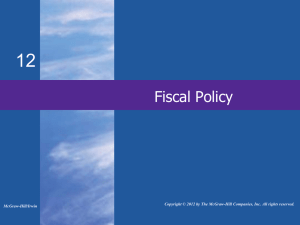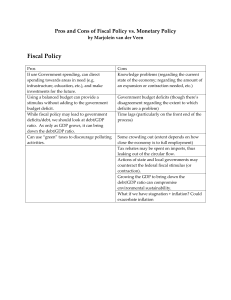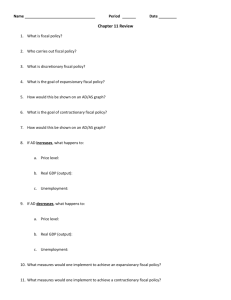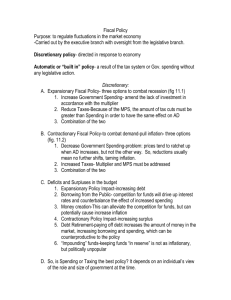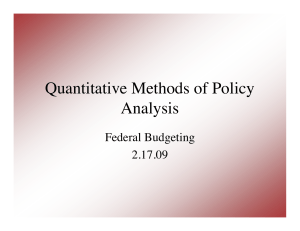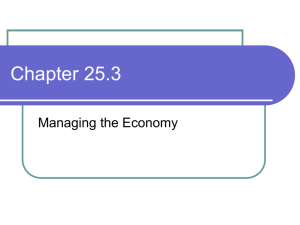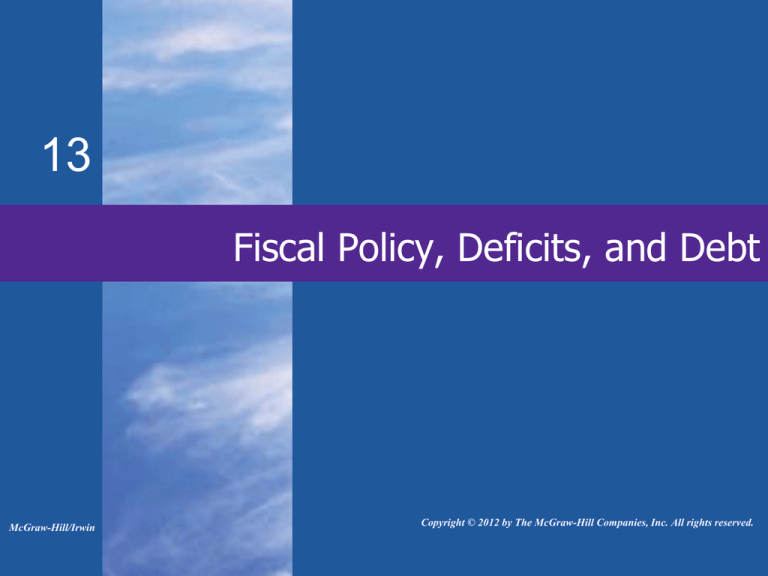
13
Fiscal Policy, Deficits, and Debt
McGraw-Hill/Irwin
Copyright © 2012 by The McGraw-Hill Companies, Inc. All rights reserved.
Fiscal Policy
• Deliberate changes in:
• Government spending
• Taxes
• Designed to:
• Achieve full-employment
• Control inflation
• Encourage economic growth
LO1
13-2
Expansionary Fiscal Policy
• Use during a recession
• Increase government spending
• Decrease taxes
• Combination of both
• Create a deficit
LO1
13-3
Expansionary Fiscal Policy
$5 billion
increase in
spending
Recessions
Decrease AD
Price level
AS
Full $20 billion
increase in
aggregate demand
P1
AD1
AD2
$490
$510
Real GDP (billions)
LO1
13-4
Contractionary Fiscal Policy
• Use during demand-pull inflation
• Decrease government spending
• Increase taxes
• Combination of both
• Create a surplus
LO1
13-5
Contractionary Fiscal Policy
$3 billion initial
decrease in
spending
Price level
AS
P2
P1
d
c
Full $12 billion
decrease in
aggregate demand
b
a
AD4
AD
AD3 5
$502 $510
$522
Real GDP (billions)
LO1
13-6
Policy Options: G or T?
• To expand the size of government
• If recession, then increase
•
LO1
government spending
• If inflation, then increase taxes
To reduce the size of government
• If recession, then decrease taxes
• If inflation, then decrease
government spending
13-7
Built-In Stability
• Automatic stabilizers
• Taxes vary directly with GDP
• Transfers vary inversely with GDP
• Reduces severity of business
•
LO2
fluctuations
Tax progressivity
• Progressive tax system
• Proportional tax system
• Regressive tax system
13-8
Built-In Stability
Government expenditures, G,
and tax revenues, T
T
Surplus
G
Deficit
GDP1 GDP2
GDP3
Real domestic output, GDP
LO2
13-9
Fiscal Policy: The Great Recession
• Financial market problems began in
•
•
•
LO4
2007
Credit market freeze
Pessimism spreads to the overall
economy
Recession officially began December
2007 and lasted 18 months
13-10
Problems, Criticisms, & Complications
• Problems of Timing
• Recognition lag
• Administrative lag
• Operational lag
• Political business cycles
• Future policy reversals
• Off-setting state and local finance
• Crowding-out effect
LO4
13-11
Current Thinking on Fiscal Policy
• Let the Federal Reserve handle short•
•
•
LO4
term fluctuations
Fiscal policy should be evaluated in
terms of long-term effects
Use tax cuts to enhance work effort,
investment, and innovation
Use government spending on public
capital projects
13-12
The U.S. Public Debt
• $11.9 trillion in 2009
• The accumulation of years of
•
LO4
federal deficits and surpluses
Owed to the holders of U.S. securities
• Treasury bills
• Treasury notes
• Treasury bonds
• U.S. savings bonds
13-13
The U.S. Public Debt
Debt held
outside
the Federal
government
and the
Federal
Reserve:
57%
LO4
Debt held by
the Federal
government
and the
Federal
Reserve:
43%
13-14
Global Perspective
Public Sector Debt as
Percentage of GDP, 2009
0
20
40
60
80
100
Italy
Japan
Greece
Belgium
France
United States
France
Germany
United Kingdom
Spain
Netherlands
Canada
Source: Organization for Economic Cooperation and Development, OECD
LO4
13-15
The U.S. Public Debt
• Interest charges on debt
• Largest burden of the debt
• 1.3% of GDP in 2009
• False Concerns
• Bankruptcy
• Refinancing
• Taxation
• Burdening future generations
LO4
13-16
Substantive Issues
• Income distribution
• Incentives
• Foreign-owned public debt
• Crowding-out effect revisited
• Future generations
• Public investment
LO4
13-17
Crowding-Out Effect
Real interest rate (percent)
16
14
12
b
10
8
a
6
Crowding-out
effect
4
ID2
2
ID1
0
LO4
c
Increase in
investment
demand
5
10 15 20 25 30 35
Investment (billions of dollars)
40
13-18

